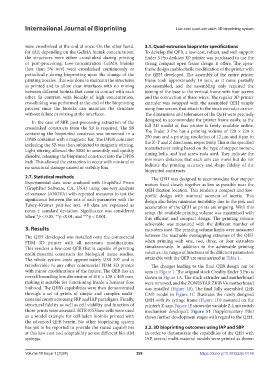Page 306 - IJB-10-1
P. 306
International Journal of Bioprinting Low-cost quad-extrusion 3D bioprinting system
were crosslinked at the end at once. On the other hand, 3.1. Quad-extrusion bioprinter specifications
for IAP, depending on the GelMA bioink concentration, To develop the QEB, a low-cost, robust, and well-support
the structures were either crosslinked during printing Ender 3 Pro desktop 3D printer was purchased to use the
or post-processing. Low-concentration GelMA bioinks strong compact open frame design it offers. The open-
(less than 5% w/v) were crosslinked continuously or frame design enables facile modification of the printer with
periodically during bioprinting upon the change of the the QEH developed. The assembly of the entire printer
printing nozzles. This was done to maintain the structures frame took approximately 10 min, as it came partially
as printed and to allow clear interfaces with no mixing pre-assembled, and the assembling only required the
between different bioinks that come in contact with each joining of the base to the vertical frame with four screws
other. In contrast, with bioinks of high concentration, and the connection of three wires. The regular 3D printer
crosslinking was performed at the end of the bioprinting extruder was swapped with the assembled QEH simply
process since the bioinks can maintain the structure using four screws that attach to the stock extruder carrier.
without failure or mixing at the interfaces. The dimensions and tolerances of the QEH were precisely
In the case of SBP, post-processing extraction of the designed to accommodate the printer frame easily, as the
crosslinked constructs from the SB is required. The SB full 3D model of that printer is freely available online.
containing the bioprinted construct was immersed in a The Ender 3 Pro has a printing volume of 220 × 220 ×
DPBS container with a magnetic bar. The DPBS container 250 mm and a printing resolution of 12 µm and 4 µm in
including the SB was then subjected to magnetic stirring. the X–Y and Z directions, respectively. This is the specified
Light stirring allowed the SBM to smoothly and quickly manufacturer rating based on the type of stepper motors,
dissolve, releasing the bioprinted construct into the DPBS timing belts, and lead screw rods used. They indicate the
bath. This allowed the extraction to occur with minimal or minimum distances that each axis can move but do not
no structural damage caused or viability loss. indicate the printing accuracy and shape fidelity of the
bioprinted constructs.
2.7. Statistical methods The QEH was designed to accommodate four stepper
Experimental data were analyzed with GraphPad Prism motors fixed closely together as low as possible near the
(GraphPad Software, CA, USA) using one-way analysis QEH fixation location. This renders a compact and low-
of variance (ANOVA) with repeated measures to test the profile design with minimal moment of inertia. This
significance between the sets of each parameter with the design also helps minimize instability due to the jerk and
Tukey–Kramer post-hoc test. All data are expressed as acceleration of the QEH as prints are ongoing. With this
mean ± standard deviation. Significance was considered setup, the available printing volume was maximized with
when *p < 0.05, **p <0.01, and ***p < 0.001. this efficient and compact design. The printing volume
achievable was measured with the different number of
3. Results extruders used. The printing volume limits were measured
The QEH developed was installed onto the commercial between the reachable overlapping extremes of the QEH
FDM 3D printer with all necessary modifications. when printing with one, two, three, or four extruders
This renders a low-cost QEB that is capable of printing simultaneously. In addition to the achievable printing
multi-material constructs for biological tissue studies. volumes, the ranges of functions of the different parameters
The whole system costs approximately US$ 297 and is attainable with the QEB are summarized in Table 1.
transferrable to any other commercial FDM 3D printer The changes leading to the final QEB design can be
with minor modifications of the fixture. The QEB has an seen in Figure 1. The original stock Creality Ender 3 Pro is
overall bounding box dimension of 410 × 430 × 465 mm, shown in Figure 1A. The stock extruder and motherboard
making it suitable for functioning inside a laminar flow were removed, and the ZONESTAR ZRIB V6 motherboard
biohood. The QEB’s capabilities were then demonstrated was installed (Figure 1B). The final fully assembled QEB
through a set of prints of simple and complex multi- CAD model in Figure 1C illustrates the newly designed
material constructs using SBP and IAP paradigms. Finally, QEH with its syringe frame (Figure 1D) mounted on the
structural fidelity as well as cell viability and function of printer’s X-axis. Figure 1E shows the variable Z-limit switch
those prints were assessed. HTR-8/SVneo cells were used mechanism developed. Figure S1 (Supplementary File)
as a model example for cell-laden bioinks printed with shows further development stages with regard to the QEH.
the advanced QEB herein. No other bioprinting system
has yet to be reported to provide the stated capabilities 3.2. 3D bioprinting outcomes using IAP and SBP
at this low cost and adaptability across different bio-AM In order to demonstrate the capabilities of the QEB with
systems. IAP, several multi-material models were printed as shown
Volume 10 Issue 1 (2024) 298 https://doi.org/10.36922/ijb.0159

